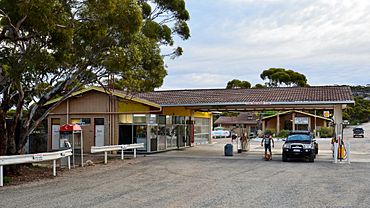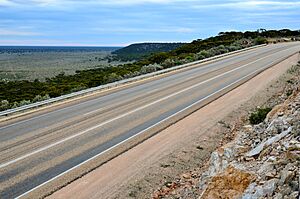Madura, Western Australia facts for kids
Quick facts for kids MaduraWestern Australia |
|
|---|---|

Madura Roadhouse, 2017
|
|
| Established | 1876 |
| Postcode(s) | 6443 |
| Area | [convert: needs a number] |
| Location | |
| LGA(s) | Shire of Dundas |
| State electorate(s) | Eyre |
| Federal Division(s) | O'Connor |
Madura is a small community in Western Australia. It's mostly known for its roadhouse, a place where travelers can stop for fuel and food. You'll find Madura on the Eyre Highway, which is a long road crossing the southern part of Australia. It sits at the bottom of a big slope called the Madura Pass, near the vast Nullarbor Plain. Madura is about 1,253 kilometers (779 miles) from Perth.
Contents
History of Madura
Early Settlement in 1876
Madura was first settled in 1876. It was chosen as a special place to breed horses. These horses were strong cavalry horses. They were raised for the British Indian Army. The army used them in a region that was once part of India, now in Pakistan.
Horse Breeding and Transport
The horses bred at Madura were very important. They were shipped from the coast at Eucla. Madura was a good spot for breeding because it had rare, free-flowing water from underground. This water was essential for the horses.
Madura Station's Past and Present
The land around Madura is called Madura Station. Today, it is a large sheep station. In the past, it was used to graze other animals too. These included cattle, horses, and even camels.
Madura Today
The Roadhouse Community
Like many places on the Nullarbor Plain, Madura is a small community. It mainly consists of a roadhouse. This roadhouse is open every day from 6:00 AM to 9:00 PM. It provides services for people traveling along the Eyre Highway.
Exploring Madura Pass and Roe Plains
Just two kilometers west of Madura, there is a scenic lookout. From here, you can see amazing views of the Madura Pass. This pass goes across a steep slope called an escarpment. Below, you can see the wide Roe Plains.
Natural Blowholes and Local Activities
Near Madura, you might also find natural blowholes. These are holes in the ground where air is pushed out. The surrounding area is still used for farming. Raising sheep is the main activity here.
The Madura Shelf
Underneath Madura is an area called the Madura Shelf. This large area covers about 265,600 square kilometers. It is mostly made of sedimentary rock. Scientists have found that this area might contain crude oil. It also has interesting geothermal gradients, which means the temperature deep underground changes.



